Evidence-Based Practice in Renal Nursing: Managing Catheter Occlusion
VerifiedAdded on 2023/04/21
|11
|3103
|491
Report
AI Summary
This report delves into evidence-based practices within renal nursing, specifically addressing the common issue of catheter occlusion in hemodialysis patients. The analysis focuses on comparing the effectiveness of alteplase and urokinase as thrombolytic agents for restoring catheter patency and preventing thrombosis. Three research articles are critically reviewed, examining study designs, data findings, and limitations. The report highlights the potential benefits of implementing evidence-based practice in renal care, including improved intervention quality, enhanced nursing competence, and the adoption of novel techniques for managing catheter-related complications. The findings suggest that alteplase may offer superior outcomes in restoring catheter patency compared to urokinase, although further research with larger sample sizes is warranted to confirm these results and optimize clinical protocols.
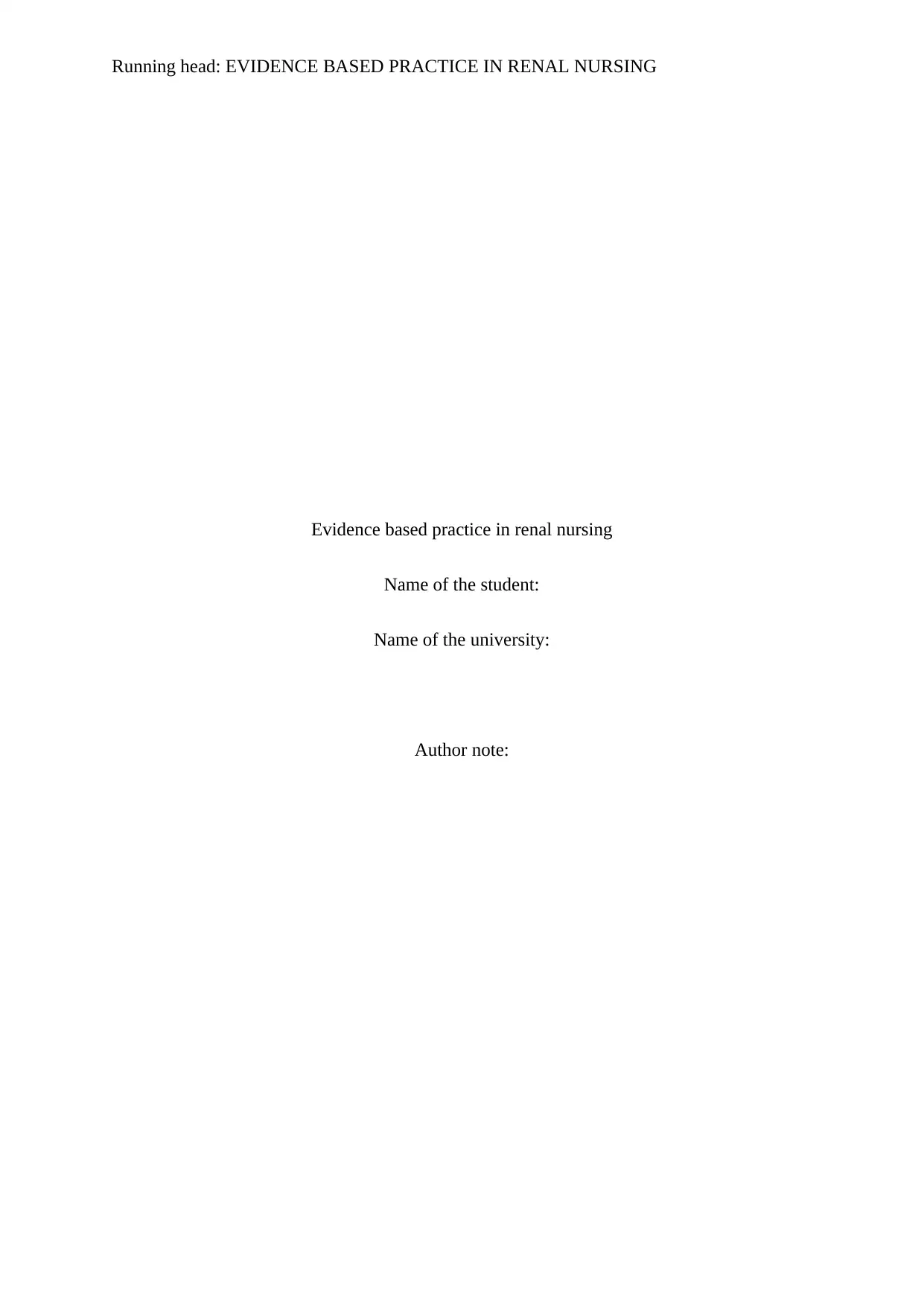
Running head: EVIDENCE BASED PRACTICE IN RENAL NURSING
Evidence based practice in renal nursing
Name of the student:
Name of the university:
Author note:
Evidence based practice in renal nursing
Name of the student:
Name of the university:
Author note:
Paraphrase This Document
Need a fresh take? Get an instant paraphrase of this document with our AI Paraphraser
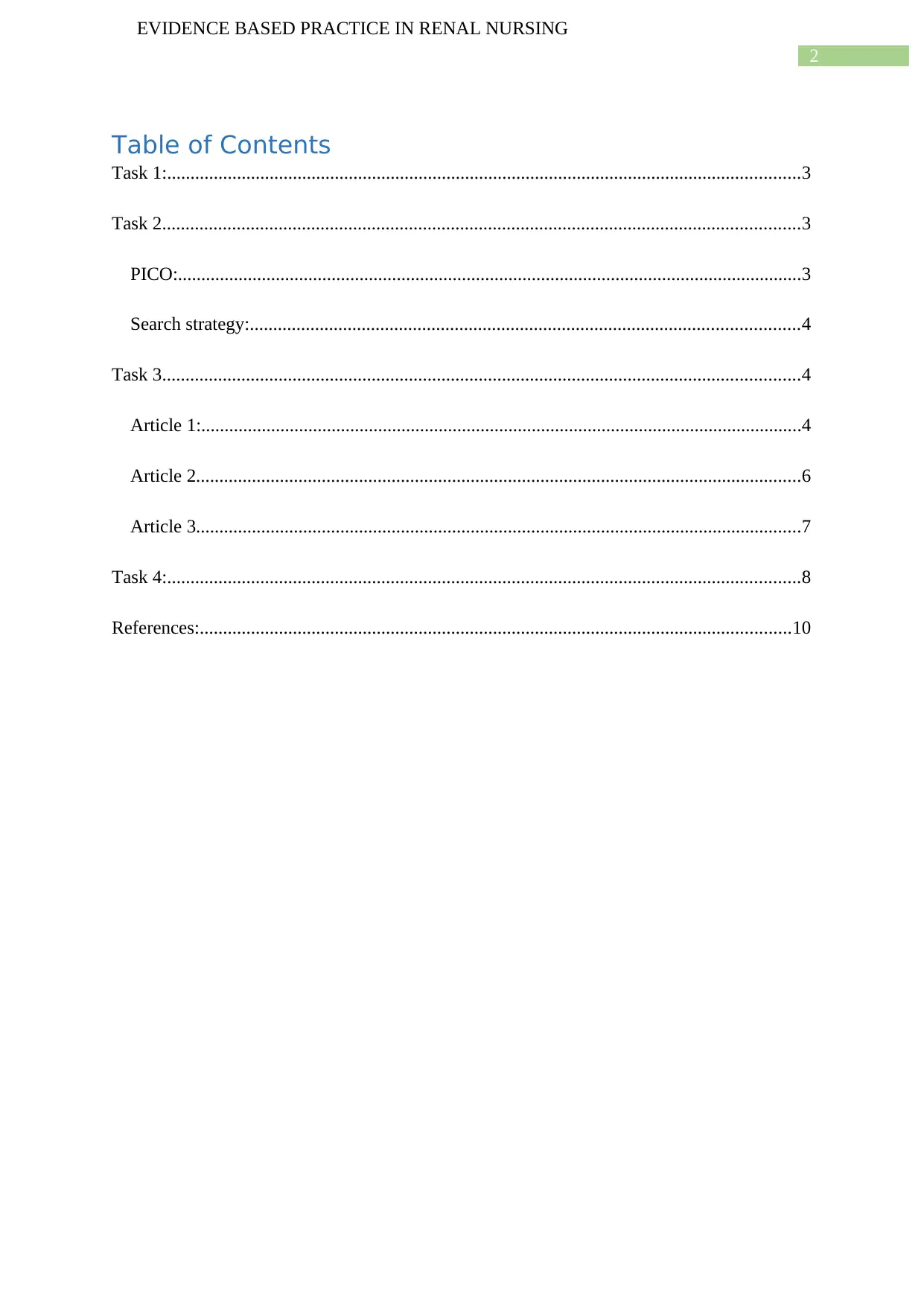
2
EVIDENCE BASED PRACTICE IN RENAL NURSING
Table of Contents
Task 1:........................................................................................................................................3
Task 2.........................................................................................................................................3
PICO:......................................................................................................................................3
Search strategy:......................................................................................................................4
Task 3.........................................................................................................................................4
Article 1:.................................................................................................................................4
Article 2..................................................................................................................................6
Article 3..................................................................................................................................7
Task 4:........................................................................................................................................8
References:...............................................................................................................................10
EVIDENCE BASED PRACTICE IN RENAL NURSING
Table of Contents
Task 1:........................................................................................................................................3
Task 2.........................................................................................................................................3
PICO:......................................................................................................................................3
Search strategy:......................................................................................................................4
Task 3.........................................................................................................................................4
Article 1:.................................................................................................................................4
Article 2..................................................................................................................................6
Article 3..................................................................................................................................7
Task 4:........................................................................................................................................8
References:...............................................................................................................................10
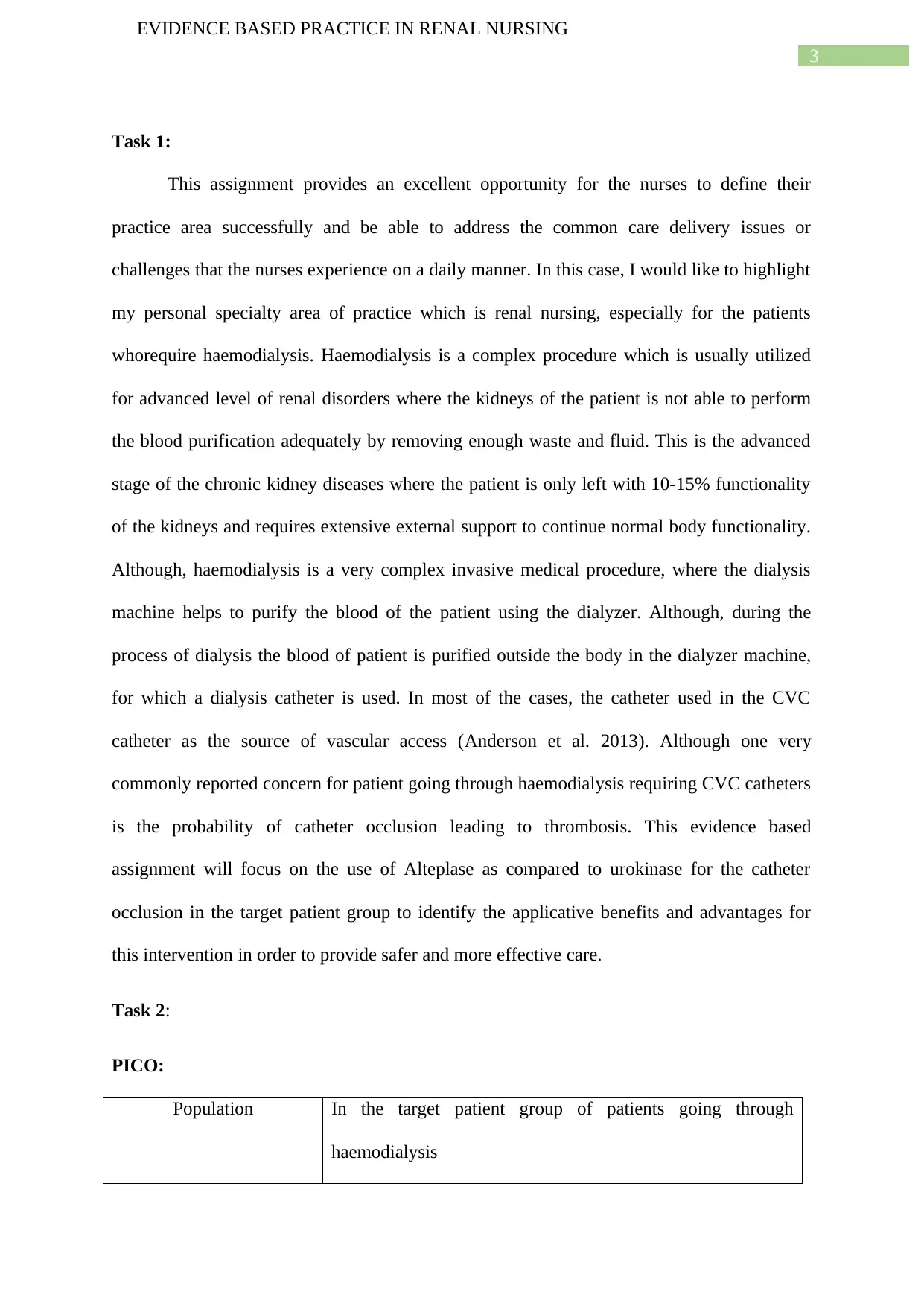
3
EVIDENCE BASED PRACTICE IN RENAL NURSING
Task 1:
This assignment provides an excellent opportunity for the nurses to define their
practice area successfully and be able to address the common care delivery issues or
challenges that the nurses experience on a daily manner. In this case, I would like to highlight
my personal specialty area of practice which is renal nursing, especially for the patients
whorequire haemodialysis. Haemodialysis is a complex procedure which is usually utilized
for advanced level of renal disorders where the kidneys of the patient is not able to perform
the blood purification adequately by removing enough waste and fluid. This is the advanced
stage of the chronic kidney diseases where the patient is only left with 10-15% functionality
of the kidneys and requires extensive external support to continue normal body functionality.
Although, haemodialysis is a very complex invasive medical procedure, where the dialysis
machine helps to purify the blood of the patient using the dialyzer. Although, during the
process of dialysis the blood of patient is purified outside the body in the dialyzer machine,
for which a dialysis catheter is used. In most of the cases, the catheter used in the CVC
catheter as the source of vascular access (Anderson et al. 2013). Although one very
commonly reported concern for patient going through haemodialysis requiring CVC catheters
is the probability of catheter occlusion leading to thrombosis. This evidence based
assignment will focus on the use of Alteplase as compared to urokinase for the catheter
occlusion in the target patient group to identify the applicative benefits and advantages for
this intervention in order to provide safer and more effective care.
Task 2:
PICO:
Population In the target patient group of patients going through
haemodialysis
EVIDENCE BASED PRACTICE IN RENAL NURSING
Task 1:
This assignment provides an excellent opportunity for the nurses to define their
practice area successfully and be able to address the common care delivery issues or
challenges that the nurses experience on a daily manner. In this case, I would like to highlight
my personal specialty area of practice which is renal nursing, especially for the patients
whorequire haemodialysis. Haemodialysis is a complex procedure which is usually utilized
for advanced level of renal disorders where the kidneys of the patient is not able to perform
the blood purification adequately by removing enough waste and fluid. This is the advanced
stage of the chronic kidney diseases where the patient is only left with 10-15% functionality
of the kidneys and requires extensive external support to continue normal body functionality.
Although, haemodialysis is a very complex invasive medical procedure, where the dialysis
machine helps to purify the blood of the patient using the dialyzer. Although, during the
process of dialysis the blood of patient is purified outside the body in the dialyzer machine,
for which a dialysis catheter is used. In most of the cases, the catheter used in the CVC
catheter as the source of vascular access (Anderson et al. 2013). Although one very
commonly reported concern for patient going through haemodialysis requiring CVC catheters
is the probability of catheter occlusion leading to thrombosis. This evidence based
assignment will focus on the use of Alteplase as compared to urokinase for the catheter
occlusion in the target patient group to identify the applicative benefits and advantages for
this intervention in order to provide safer and more effective care.
Task 2:
PICO:
Population In the target patient group of patients going through
haemodialysis
⊘ This is a preview!⊘
Do you want full access?
Subscribe today to unlock all pages.

Trusted by 1+ million students worldwide
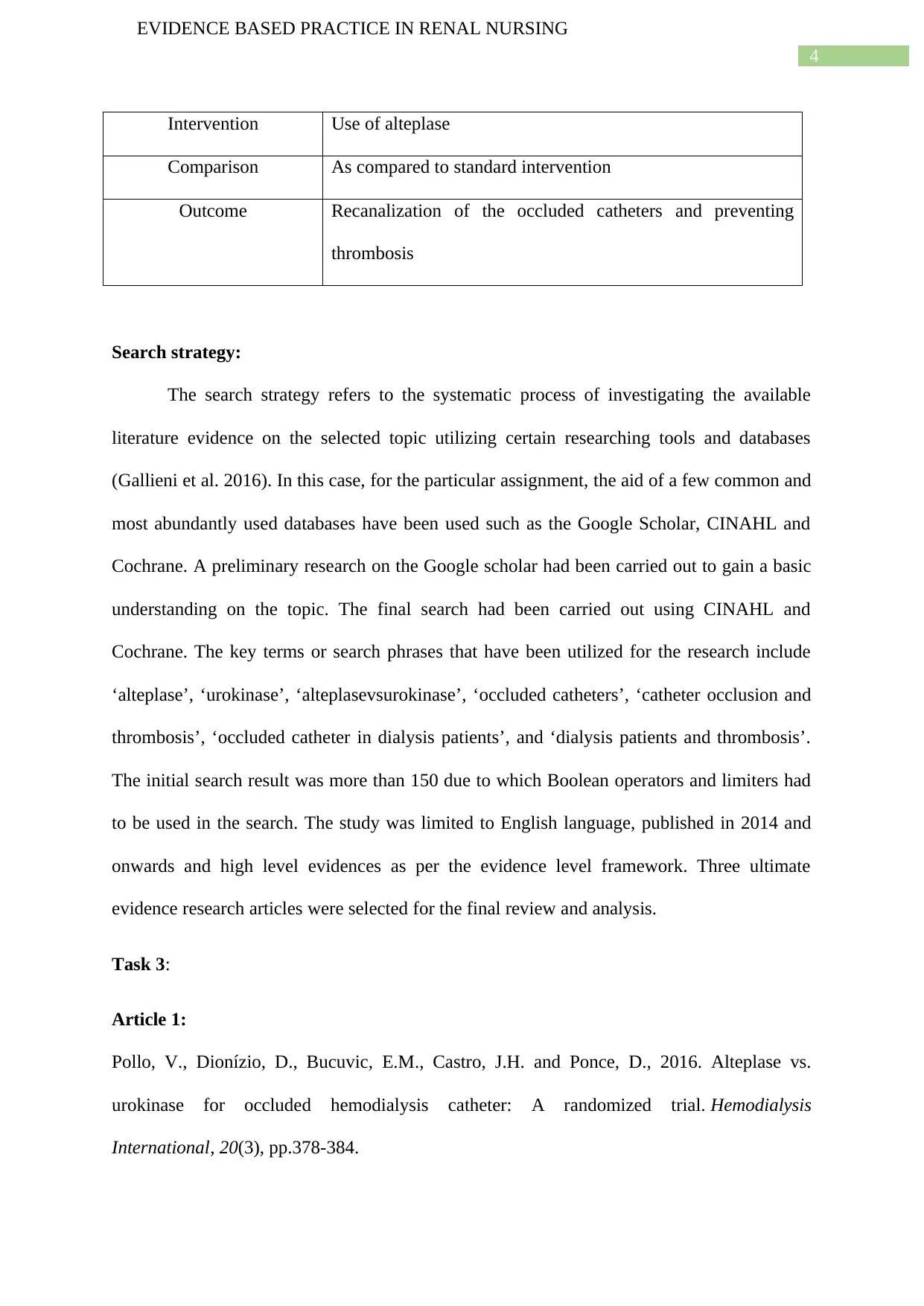
4
EVIDENCE BASED PRACTICE IN RENAL NURSING
Intervention Use of alteplase
Comparison As compared to standard intervention
Outcome Recanalization of the occluded catheters and preventing
thrombosis
Search strategy:
The search strategy refers to the systematic process of investigating the available
literature evidence on the selected topic utilizing certain researching tools and databases
(Gallieni et al. 2016). In this case, for the particular assignment, the aid of a few common and
most abundantly used databases have been used such as the Google Scholar, CINAHL and
Cochrane. A preliminary research on the Google scholar had been carried out to gain a basic
understanding on the topic. The final search had been carried out using CINAHL and
Cochrane. The key terms or search phrases that have been utilized for the research include
‘alteplase’, ‘urokinase’, ‘alteplasevsurokinase’, ‘occluded catheters’, ‘catheter occlusion and
thrombosis’, ‘occluded catheter in dialysis patients’, and ‘dialysis patients and thrombosis’.
The initial search result was more than 150 due to which Boolean operators and limiters had
to be used in the search. The study was limited to English language, published in 2014 and
onwards and high level evidences as per the evidence level framework. Three ultimate
evidence research articles were selected for the final review and analysis.
Task 3:
Article 1:
Pollo, V., Dionízio, D., Bucuvic, E.M., Castro, J.H. and Ponce, D., 2016. Alteplase vs.
urokinase for occluded hemodialysis catheter: A randomized trial. Hemodialysis
International, 20(3), pp.378-384.
EVIDENCE BASED PRACTICE IN RENAL NURSING
Intervention Use of alteplase
Comparison As compared to standard intervention
Outcome Recanalization of the occluded catheters and preventing
thrombosis
Search strategy:
The search strategy refers to the systematic process of investigating the available
literature evidence on the selected topic utilizing certain researching tools and databases
(Gallieni et al. 2016). In this case, for the particular assignment, the aid of a few common and
most abundantly used databases have been used such as the Google Scholar, CINAHL and
Cochrane. A preliminary research on the Google scholar had been carried out to gain a basic
understanding on the topic. The final search had been carried out using CINAHL and
Cochrane. The key terms or search phrases that have been utilized for the research include
‘alteplase’, ‘urokinase’, ‘alteplasevsurokinase’, ‘occluded catheters’, ‘catheter occlusion and
thrombosis’, ‘occluded catheter in dialysis patients’, and ‘dialysis patients and thrombosis’.
The initial search result was more than 150 due to which Boolean operators and limiters had
to be used in the search. The study was limited to English language, published in 2014 and
onwards and high level evidences as per the evidence level framework. Three ultimate
evidence research articles were selected for the final review and analysis.
Task 3:
Article 1:
Pollo, V., Dionízio, D., Bucuvic, E.M., Castro, J.H. and Ponce, D., 2016. Alteplase vs.
urokinase for occluded hemodialysis catheter: A randomized trial. Hemodialysis
International, 20(3), pp.378-384.
Paraphrase This Document
Need a fresh take? Get an instant paraphrase of this document with our AI Paraphraser
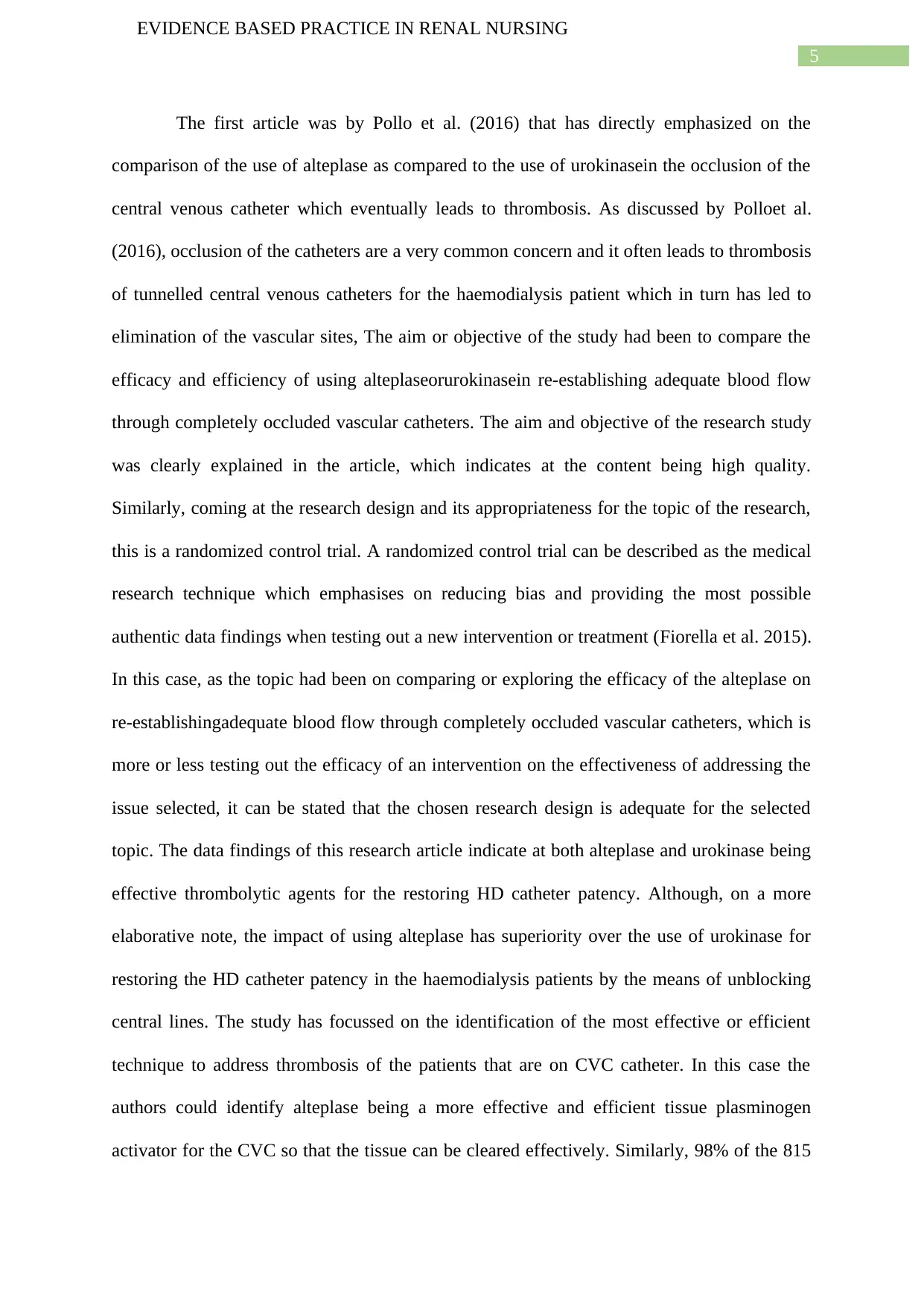
5
EVIDENCE BASED PRACTICE IN RENAL NURSING
The first article was by Pollo et al. (2016) that has directly emphasized on the
comparison of the use of alteplase as compared to the use of urokinasein the occlusion of the
central venous catheter which eventually leads to thrombosis. As discussed by Polloet al.
(2016), occlusion of the catheters are a very common concern and it often leads to thrombosis
of tunnelled central venous catheters for the haemodialysis patient which in turn has led to
elimination of the vascular sites, The aim or objective of the study had been to compare the
efficacy and efficiency of using alteplaseorurokinasein re-establishing adequate blood flow
through completely occluded vascular catheters. The aim and objective of the research study
was clearly explained in the article, which indicates at the content being high quality.
Similarly, coming at the research design and its appropriateness for the topic of the research,
this is a randomized control trial. A randomized control trial can be described as the medical
research technique which emphasises on reducing bias and providing the most possible
authentic data findings when testing out a new intervention or treatment (Fiorella et al. 2015).
In this case, as the topic had been on comparing or exploring the efficacy of the alteplase on
re-establishingadequate blood flow through completely occluded vascular catheters, which is
more or less testing out the efficacy of an intervention on the effectiveness of addressing the
issue selected, it can be stated that the chosen research design is adequate for the selected
topic. The data findings of this research article indicate at both alteplase and urokinase being
effective thrombolytic agents for the restoring HD catheter patency. Although, on a more
elaborative note, the impact of using alteplase has superiority over the use of urokinase for
restoring the HD catheter patency in the haemodialysis patients by the means of unblocking
central lines. The study has focussed on the identification of the most effective or efficient
technique to address thrombosis of the patients that are on CVC catheter. In this case the
authors could identify alteplase being a more effective and efficient tissue plasminogen
activator for the CVC so that the tissue can be cleared effectively. Similarly, 98% of the 815
EVIDENCE BASED PRACTICE IN RENAL NURSING
The first article was by Pollo et al. (2016) that has directly emphasized on the
comparison of the use of alteplase as compared to the use of urokinasein the occlusion of the
central venous catheter which eventually leads to thrombosis. As discussed by Polloet al.
(2016), occlusion of the catheters are a very common concern and it often leads to thrombosis
of tunnelled central venous catheters for the haemodialysis patient which in turn has led to
elimination of the vascular sites, The aim or objective of the study had been to compare the
efficacy and efficiency of using alteplaseorurokinasein re-establishing adequate blood flow
through completely occluded vascular catheters. The aim and objective of the research study
was clearly explained in the article, which indicates at the content being high quality.
Similarly, coming at the research design and its appropriateness for the topic of the research,
this is a randomized control trial. A randomized control trial can be described as the medical
research technique which emphasises on reducing bias and providing the most possible
authentic data findings when testing out a new intervention or treatment (Fiorella et al. 2015).
In this case, as the topic had been on comparing or exploring the efficacy of the alteplase on
re-establishingadequate blood flow through completely occluded vascular catheters, which is
more or less testing out the efficacy of an intervention on the effectiveness of addressing the
issue selected, it can be stated that the chosen research design is adequate for the selected
topic. The data findings of this research article indicate at both alteplase and urokinase being
effective thrombolytic agents for the restoring HD catheter patency. Although, on a more
elaborative note, the impact of using alteplase has superiority over the use of urokinase for
restoring the HD catheter patency in the haemodialysis patients by the means of unblocking
central lines. The study has focussed on the identification of the most effective or efficient
technique to address thrombosis of the patients that are on CVC catheter. In this case the
authors could identify alteplase being a more effective and efficient tissue plasminogen
activator for the CVC so that the tissue can be cleared effectively. Similarly, 98% of the 815
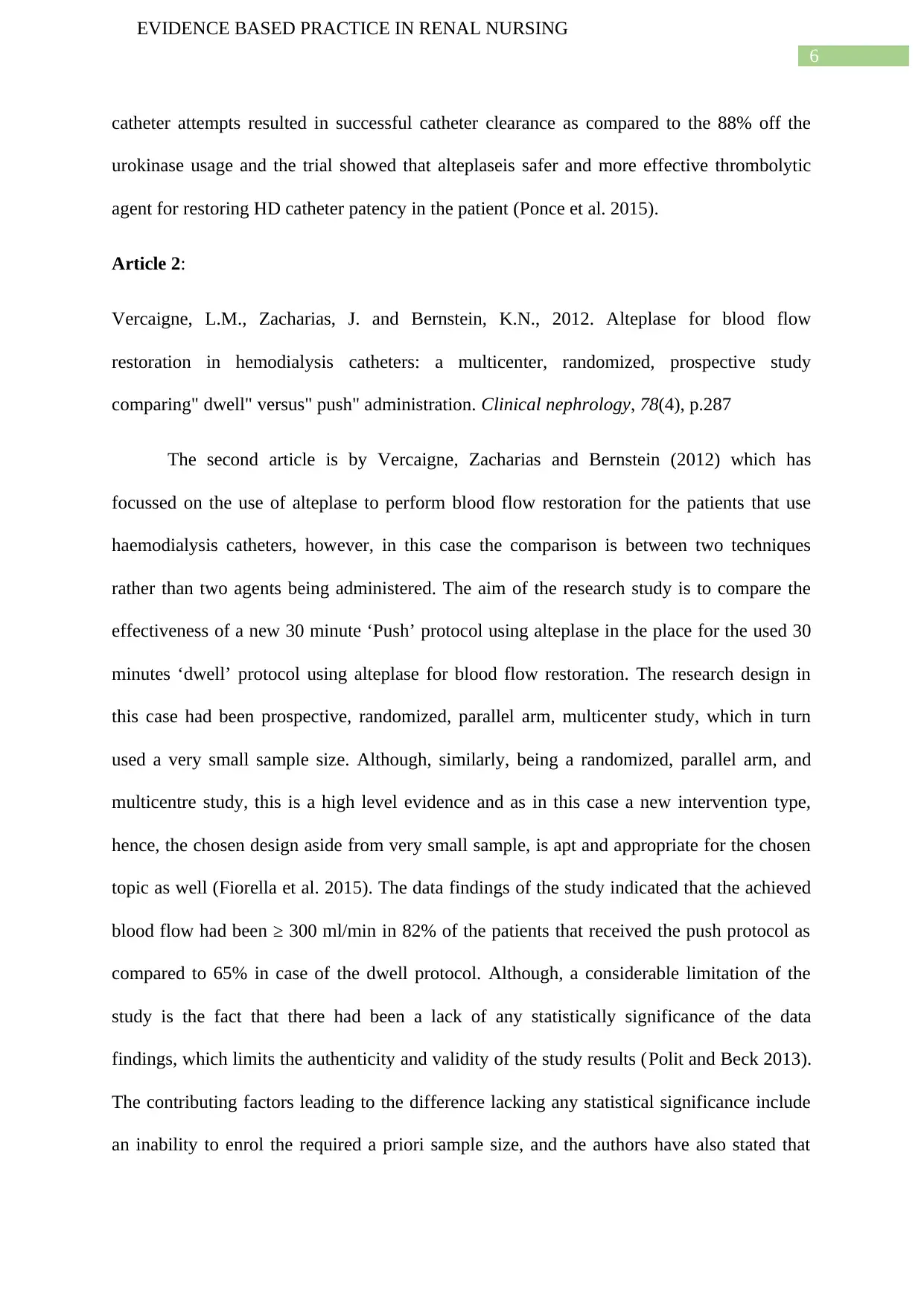
6
EVIDENCE BASED PRACTICE IN RENAL NURSING
catheter attempts resulted in successful catheter clearance as compared to the 88% off the
urokinase usage and the trial showed that alteplaseis safer and more effective thrombolytic
agent for restoring HD catheter patency in the patient (Ponce et al. 2015).
Article 2:
Vercaigne, L.M., Zacharias, J. and Bernstein, K.N., 2012. Alteplase for blood flow
restoration in hemodialysis catheters: a multicenter, randomized, prospective study
comparing" dwell" versus" push" administration. Clinical nephrology, 78(4), p.287
The second article is by Vercaigne, Zacharias and Bernstein (2012) which has
focussed on the use of alteplase to perform blood flow restoration for the patients that use
haemodialysis catheters, however, in this case the comparison is between two techniques
rather than two agents being administered. The aim of the research study is to compare the
effectiveness of a new 30 minute ‘Push’ protocol using alteplase in the place for the used 30
minutes ‘dwell’ protocol using alteplase for blood flow restoration. The research design in
this case had been prospective, randomized, parallel arm, multicenter study, which in turn
used a very small sample size. Although, similarly, being a randomized, parallel arm, and
multicentre study, this is a high level evidence and as in this case a new intervention type,
hence, the chosen design aside from very small sample, is apt and appropriate for the chosen
topic as well (Fiorella et al. 2015). The data findings of the study indicated that the achieved
blood flow had been ≥ 300 ml/min in 82% of the patients that received the push protocol as
compared to 65% in case of the dwell protocol. Although, a considerable limitation of the
study is the fact that there had been a lack of any statistically significance of the data
findings, which limits the authenticity and validity of the study results (Polit and Beck 2013).
The contributing factors leading to the difference lacking any statistical significance include
an inability to enrol the required a priori sample size, and the authors have also stated that
EVIDENCE BASED PRACTICE IN RENAL NURSING
catheter attempts resulted in successful catheter clearance as compared to the 88% off the
urokinase usage and the trial showed that alteplaseis safer and more effective thrombolytic
agent for restoring HD catheter patency in the patient (Ponce et al. 2015).
Article 2:
Vercaigne, L.M., Zacharias, J. and Bernstein, K.N., 2012. Alteplase for blood flow
restoration in hemodialysis catheters: a multicenter, randomized, prospective study
comparing" dwell" versus" push" administration. Clinical nephrology, 78(4), p.287
The second article is by Vercaigne, Zacharias and Bernstein (2012) which has
focussed on the use of alteplase to perform blood flow restoration for the patients that use
haemodialysis catheters, however, in this case the comparison is between two techniques
rather than two agents being administered. The aim of the research study is to compare the
effectiveness of a new 30 minute ‘Push’ protocol using alteplase in the place for the used 30
minutes ‘dwell’ protocol using alteplase for blood flow restoration. The research design in
this case had been prospective, randomized, parallel arm, multicenter study, which in turn
used a very small sample size. Although, similarly, being a randomized, parallel arm, and
multicentre study, this is a high level evidence and as in this case a new intervention type,
hence, the chosen design aside from very small sample, is apt and appropriate for the chosen
topic as well (Fiorella et al. 2015). The data findings of the study indicated that the achieved
blood flow had been ≥ 300 ml/min in 82% of the patients that received the push protocol as
compared to 65% in case of the dwell protocol. Although, a considerable limitation of the
study is the fact that there had been a lack of any statistically significance of the data
findings, which limits the authenticity and validity of the study results (Polit and Beck 2013).
The contributing factors leading to the difference lacking any statistical significance include
an inability to enrol the required a priori sample size, and the authors have also stated that
⊘ This is a preview!⊘
Do you want full access?
Subscribe today to unlock all pages.

Trusted by 1+ million students worldwide
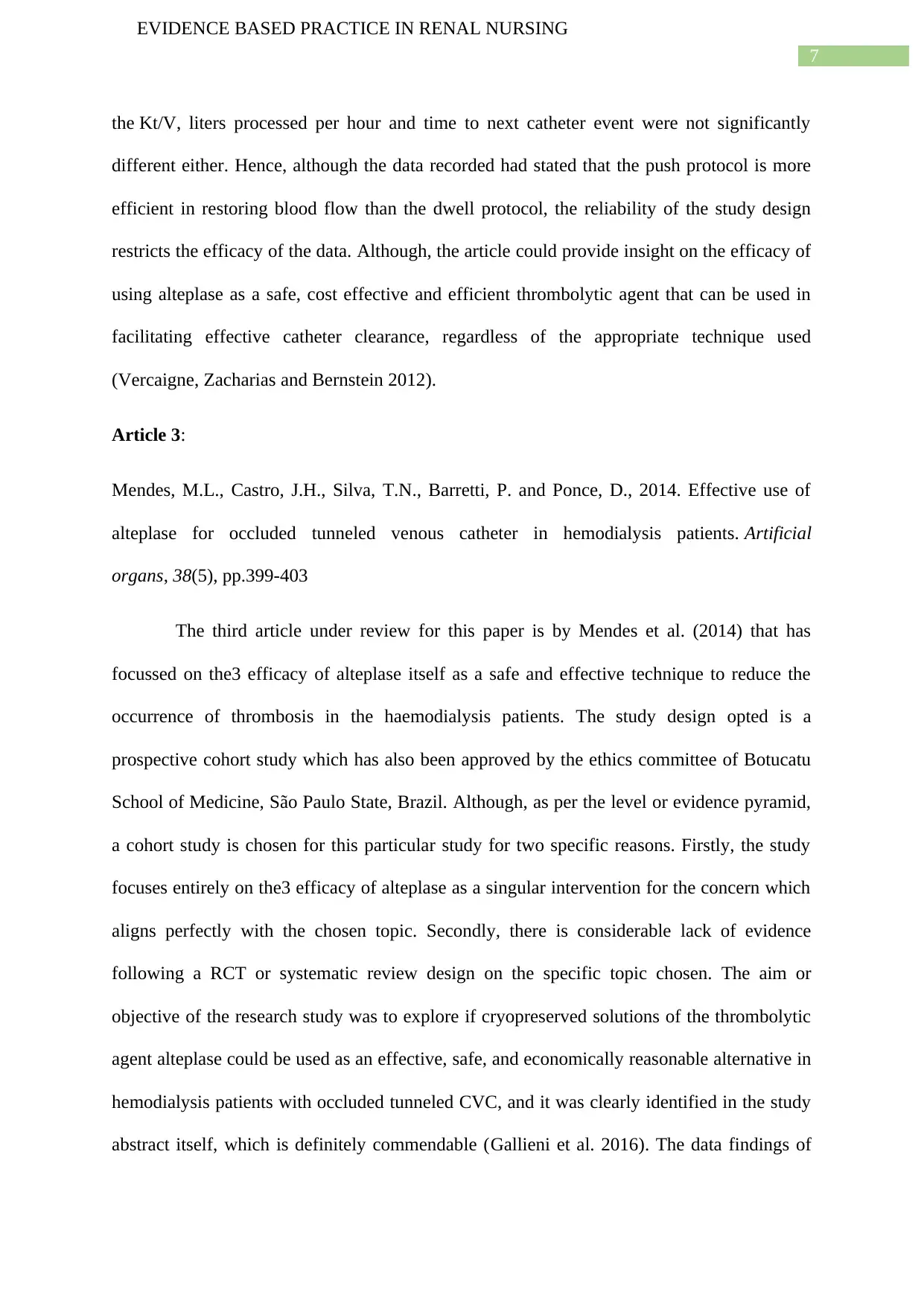
7
EVIDENCE BASED PRACTICE IN RENAL NURSING
the Kt/V, liters processed per hour and time to next catheter event were not significantly
different either. Hence, although the data recorded had stated that the push protocol is more
efficient in restoring blood flow than the dwell protocol, the reliability of the study design
restricts the efficacy of the data. Although, the article could provide insight on the efficacy of
using alteplase as a safe, cost effective and efficient thrombolytic agent that can be used in
facilitating effective catheter clearance, regardless of the appropriate technique used
(Vercaigne, Zacharias and Bernstein 2012).
Article 3:
Mendes, M.L., Castro, J.H., Silva, T.N., Barretti, P. and Ponce, D., 2014. Effective use of
alteplase for occluded tunneled venous catheter in hemodialysis patients. Artificial
organs, 38(5), pp.399-403
The third article under review for this paper is by Mendes et al. (2014) that has
focussed on the3 efficacy of alteplase itself as a safe and effective technique to reduce the
occurrence of thrombosis in the haemodialysis patients. The study design opted is a
prospective cohort study which has also been approved by the ethics committee of Botucatu
School of Medicine, São Paulo State, Brazil. Although, as per the level or evidence pyramid,
a cohort study is chosen for this particular study for two specific reasons. Firstly, the study
focuses entirely on the3 efficacy of alteplase as a singular intervention for the concern which
aligns perfectly with the chosen topic. Secondly, there is considerable lack of evidence
following a RCT or systematic review design on the specific topic chosen. The aim or
objective of the research study was to explore if cryopreserved solutions of the thrombolytic
agent alteplase could be used as an effective, safe, and economically reasonable alternative in
hemodialysis patients with occluded tunneled CVC, and it was clearly identified in the study
abstract itself, which is definitely commendable (Gallieni et al. 2016). The data findings of
EVIDENCE BASED PRACTICE IN RENAL NURSING
the Kt/V, liters processed per hour and time to next catheter event were not significantly
different either. Hence, although the data recorded had stated that the push protocol is more
efficient in restoring blood flow than the dwell protocol, the reliability of the study design
restricts the efficacy of the data. Although, the article could provide insight on the efficacy of
using alteplase as a safe, cost effective and efficient thrombolytic agent that can be used in
facilitating effective catheter clearance, regardless of the appropriate technique used
(Vercaigne, Zacharias and Bernstein 2012).
Article 3:
Mendes, M.L., Castro, J.H., Silva, T.N., Barretti, P. and Ponce, D., 2014. Effective use of
alteplase for occluded tunneled venous catheter in hemodialysis patients. Artificial
organs, 38(5), pp.399-403
The third article under review for this paper is by Mendes et al. (2014) that has
focussed on the3 efficacy of alteplase itself as a safe and effective technique to reduce the
occurrence of thrombosis in the haemodialysis patients. The study design opted is a
prospective cohort study which has also been approved by the ethics committee of Botucatu
School of Medicine, São Paulo State, Brazil. Although, as per the level or evidence pyramid,
a cohort study is chosen for this particular study for two specific reasons. Firstly, the study
focuses entirely on the3 efficacy of alteplase as a singular intervention for the concern which
aligns perfectly with the chosen topic. Secondly, there is considerable lack of evidence
following a RCT or systematic review design on the specific topic chosen. The aim or
objective of the research study was to explore if cryopreserved solutions of the thrombolytic
agent alteplase could be used as an effective, safe, and economically reasonable alternative in
hemodialysis patients with occluded tunneled CVC, and it was clearly identified in the study
abstract itself, which is definitely commendable (Gallieni et al. 2016). The data findings of
Paraphrase This Document
Need a fresh take? Get an instant paraphrase of this document with our AI Paraphraser
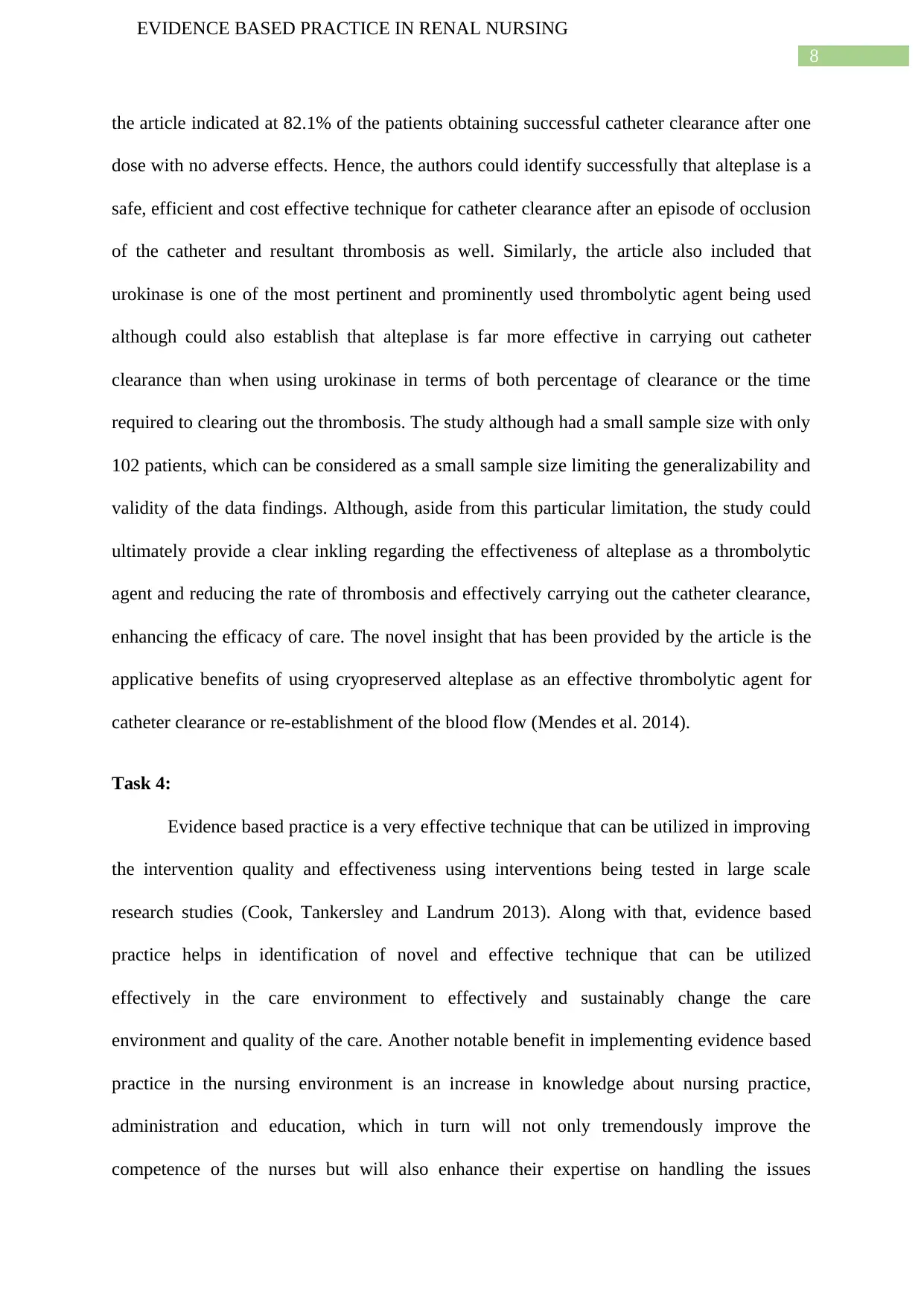
8
EVIDENCE BASED PRACTICE IN RENAL NURSING
the article indicated at 82.1% of the patients obtaining successful catheter clearance after one
dose with no adverse effects. Hence, the authors could identify successfully that alteplase is a
safe, efficient and cost effective technique for catheter clearance after an episode of occlusion
of the catheter and resultant thrombosis as well. Similarly, the article also included that
urokinase is one of the most pertinent and prominently used thrombolytic agent being used
although could also establish that alteplase is far more effective in carrying out catheter
clearance than when using urokinase in terms of both percentage of clearance or the time
required to clearing out the thrombosis. The study although had a small sample size with only
102 patients, which can be considered as a small sample size limiting the generalizability and
validity of the data findings. Although, aside from this particular limitation, the study could
ultimately provide a clear inkling regarding the effectiveness of alteplase as a thrombolytic
agent and reducing the rate of thrombosis and effectively carrying out the catheter clearance,
enhancing the efficacy of care. The novel insight that has been provided by the article is the
applicative benefits of using cryopreserved alteplase as an effective thrombolytic agent for
catheter clearance or re-establishment of the blood flow (Mendes et al. 2014).
Task 4:
Evidence based practice is a very effective technique that can be utilized in improving
the intervention quality and effectiveness using interventions being tested in large scale
research studies (Cook, Tankersley and Landrum 2013). Along with that, evidence based
practice helps in identification of novel and effective technique that can be utilized
effectively in the care environment to effectively and sustainably change the care
environment and quality of the care. Another notable benefit in implementing evidence based
practice in the nursing environment is an increase in knowledge about nursing practice,
administration and education, which in turn will not only tremendously improve the
competence of the nurses but will also enhance their expertise on handling the issues
EVIDENCE BASED PRACTICE IN RENAL NURSING
the article indicated at 82.1% of the patients obtaining successful catheter clearance after one
dose with no adverse effects. Hence, the authors could identify successfully that alteplase is a
safe, efficient and cost effective technique for catheter clearance after an episode of occlusion
of the catheter and resultant thrombosis as well. Similarly, the article also included that
urokinase is one of the most pertinent and prominently used thrombolytic agent being used
although could also establish that alteplase is far more effective in carrying out catheter
clearance than when using urokinase in terms of both percentage of clearance or the time
required to clearing out the thrombosis. The study although had a small sample size with only
102 patients, which can be considered as a small sample size limiting the generalizability and
validity of the data findings. Although, aside from this particular limitation, the study could
ultimately provide a clear inkling regarding the effectiveness of alteplase as a thrombolytic
agent and reducing the rate of thrombosis and effectively carrying out the catheter clearance,
enhancing the efficacy of care. The novel insight that has been provided by the article is the
applicative benefits of using cryopreserved alteplase as an effective thrombolytic agent for
catheter clearance or re-establishment of the blood flow (Mendes et al. 2014).
Task 4:
Evidence based practice is a very effective technique that can be utilized in improving
the intervention quality and effectiveness using interventions being tested in large scale
research studies (Cook, Tankersley and Landrum 2013). Along with that, evidence based
practice helps in identification of novel and effective technique that can be utilized
effectively in the care environment to effectively and sustainably change the care
environment and quality of the care. Another notable benefit in implementing evidence based
practice in the nursing environment is an increase in knowledge about nursing practice,
administration and education, which in turn will not only tremendously improve the
competence of the nurses but will also enhance their expertise on handling the issues
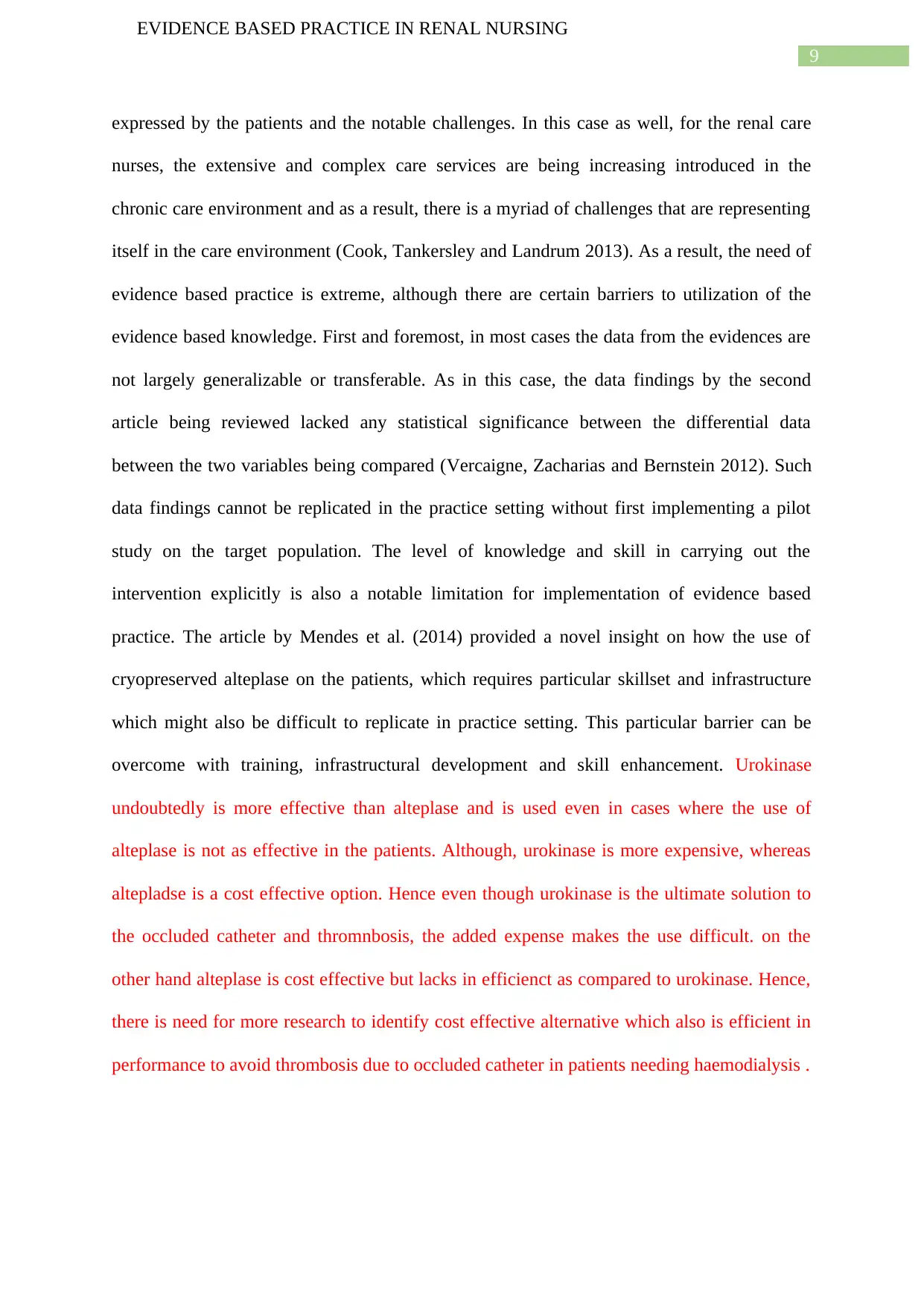
9
EVIDENCE BASED PRACTICE IN RENAL NURSING
expressed by the patients and the notable challenges. In this case as well, for the renal care
nurses, the extensive and complex care services are being increasing introduced in the
chronic care environment and as a result, there is a myriad of challenges that are representing
itself in the care environment (Cook, Tankersley and Landrum 2013). As a result, the need of
evidence based practice is extreme, although there are certain barriers to utilization of the
evidence based knowledge. First and foremost, in most cases the data from the evidences are
not largely generalizable or transferable. As in this case, the data findings by the second
article being reviewed lacked any statistical significance between the differential data
between the two variables being compared (Vercaigne, Zacharias and Bernstein 2012). Such
data findings cannot be replicated in the practice setting without first implementing a pilot
study on the target population. The level of knowledge and skill in carrying out the
intervention explicitly is also a notable limitation for implementation of evidence based
practice. The article by Mendes et al. (2014) provided a novel insight on how the use of
cryopreserved alteplase on the patients, which requires particular skillset and infrastructure
which might also be difficult to replicate in practice setting. This particular barrier can be
overcome with training, infrastructural development and skill enhancement. Urokinase
undoubtedly is more effective than alteplase and is used even in cases where the use of
alteplase is not as effective in the patients. Although, urokinase is more expensive, whereas
altepladse is a cost effective option. Hence even though urokinase is the ultimate solution to
the occluded catheter and thromnbosis, the added expense makes the use difficult. on the
other hand alteplase is cost effective but lacks in efficienct as compared to urokinase. Hence,
there is need for more research to identify cost effective alternative which also is efficient in
performance to avoid thrombosis due to occluded catheter in patients needing haemodialysis .
EVIDENCE BASED PRACTICE IN RENAL NURSING
expressed by the patients and the notable challenges. In this case as well, for the renal care
nurses, the extensive and complex care services are being increasing introduced in the
chronic care environment and as a result, there is a myriad of challenges that are representing
itself in the care environment (Cook, Tankersley and Landrum 2013). As a result, the need of
evidence based practice is extreme, although there are certain barriers to utilization of the
evidence based knowledge. First and foremost, in most cases the data from the evidences are
not largely generalizable or transferable. As in this case, the data findings by the second
article being reviewed lacked any statistical significance between the differential data
between the two variables being compared (Vercaigne, Zacharias and Bernstein 2012). Such
data findings cannot be replicated in the practice setting without first implementing a pilot
study on the target population. The level of knowledge and skill in carrying out the
intervention explicitly is also a notable limitation for implementation of evidence based
practice. The article by Mendes et al. (2014) provided a novel insight on how the use of
cryopreserved alteplase on the patients, which requires particular skillset and infrastructure
which might also be difficult to replicate in practice setting. This particular barrier can be
overcome with training, infrastructural development and skill enhancement. Urokinase
undoubtedly is more effective than alteplase and is used even in cases where the use of
alteplase is not as effective in the patients. Although, urokinase is more expensive, whereas
altepladse is a cost effective option. Hence even though urokinase is the ultimate solution to
the occluded catheter and thromnbosis, the added expense makes the use difficult. on the
other hand alteplase is cost effective but lacks in efficienct as compared to urokinase. Hence,
there is need for more research to identify cost effective alternative which also is efficient in
performance to avoid thrombosis due to occluded catheter in patients needing haemodialysis .
⊘ This is a preview!⊘
Do you want full access?
Subscribe today to unlock all pages.

Trusted by 1+ million students worldwide
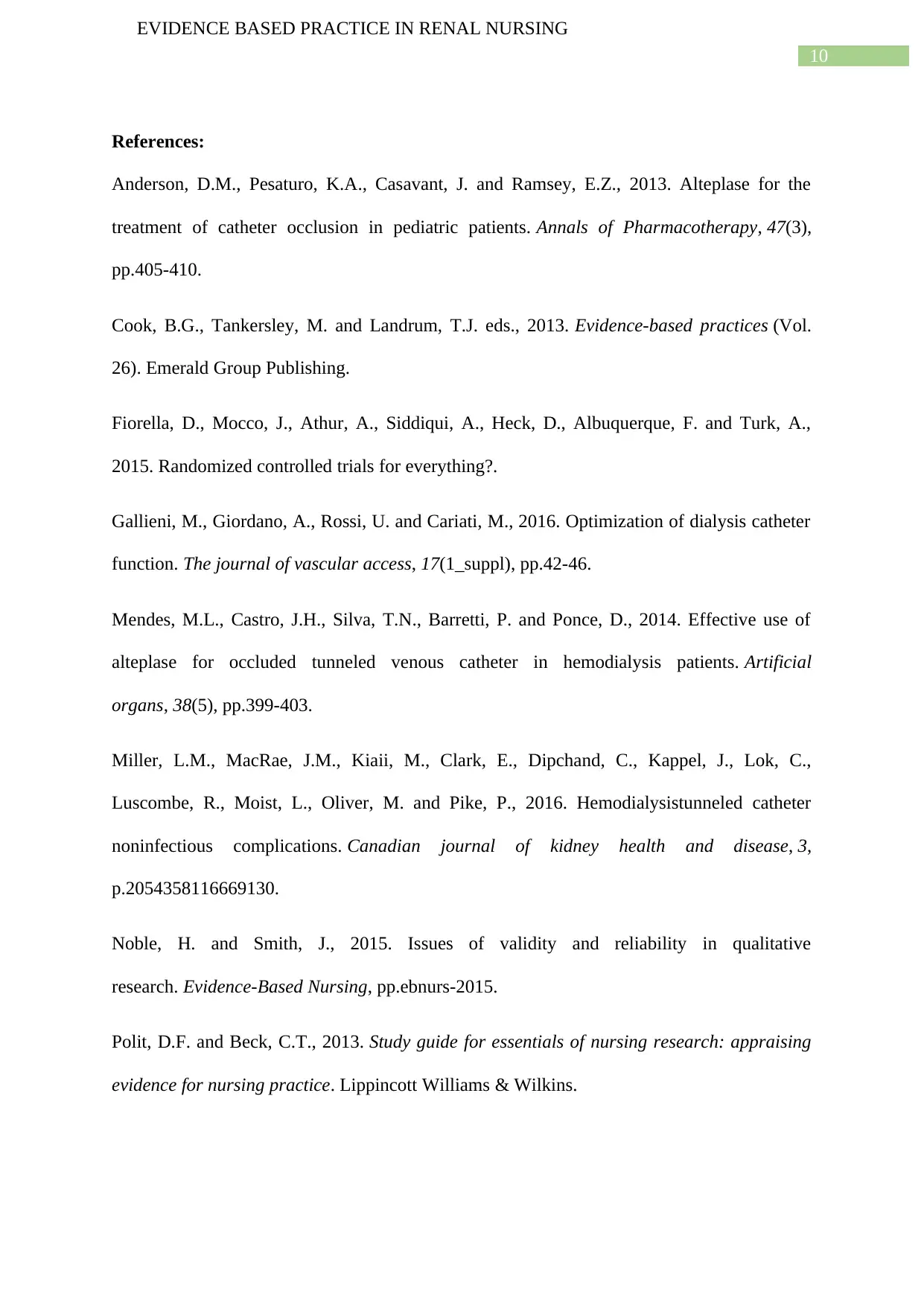
10
EVIDENCE BASED PRACTICE IN RENAL NURSING
References:
Anderson, D.M., Pesaturo, K.A., Casavant, J. and Ramsey, E.Z., 2013. Alteplase for the
treatment of catheter occlusion in pediatric patients. Annals of Pharmacotherapy, 47(3),
pp.405-410.
Cook, B.G., Tankersley, M. and Landrum, T.J. eds., 2013. Evidence-based practices (Vol.
26). Emerald Group Publishing.
Fiorella, D., Mocco, J., Athur, A., Siddiqui, A., Heck, D., Albuquerque, F. and Turk, A.,
2015. Randomized controlled trials for everything?.
Gallieni, M., Giordano, A., Rossi, U. and Cariati, M., 2016. Optimization of dialysis catheter
function. The journal of vascular access, 17(1_suppl), pp.42-46.
Mendes, M.L., Castro, J.H., Silva, T.N., Barretti, P. and Ponce, D., 2014. Effective use of
alteplase for occluded tunneled venous catheter in hemodialysis patients. Artificial
organs, 38(5), pp.399-403.
Miller, L.M., MacRae, J.M., Kiaii, M., Clark, E., Dipchand, C., Kappel, J., Lok, C.,
Luscombe, R., Moist, L., Oliver, M. and Pike, P., 2016. Hemodialysistunneled catheter
noninfectious complications. Canadian journal of kidney health and disease, 3,
p.2054358116669130.
Noble, H. and Smith, J., 2015. Issues of validity and reliability in qualitative
research. Evidence-Based Nursing, pp.ebnurs-2015.
Polit, D.F. and Beck, C.T., 2013. Study guide for essentials of nursing research: appraising
evidence for nursing practice. Lippincott Williams & Wilkins.
EVIDENCE BASED PRACTICE IN RENAL NURSING
References:
Anderson, D.M., Pesaturo, K.A., Casavant, J. and Ramsey, E.Z., 2013. Alteplase for the
treatment of catheter occlusion in pediatric patients. Annals of Pharmacotherapy, 47(3),
pp.405-410.
Cook, B.G., Tankersley, M. and Landrum, T.J. eds., 2013. Evidence-based practices (Vol.
26). Emerald Group Publishing.
Fiorella, D., Mocco, J., Athur, A., Siddiqui, A., Heck, D., Albuquerque, F. and Turk, A.,
2015. Randomized controlled trials for everything?.
Gallieni, M., Giordano, A., Rossi, U. and Cariati, M., 2016. Optimization of dialysis catheter
function. The journal of vascular access, 17(1_suppl), pp.42-46.
Mendes, M.L., Castro, J.H., Silva, T.N., Barretti, P. and Ponce, D., 2014. Effective use of
alteplase for occluded tunneled venous catheter in hemodialysis patients. Artificial
organs, 38(5), pp.399-403.
Miller, L.M., MacRae, J.M., Kiaii, M., Clark, E., Dipchand, C., Kappel, J., Lok, C.,
Luscombe, R., Moist, L., Oliver, M. and Pike, P., 2016. Hemodialysistunneled catheter
noninfectious complications. Canadian journal of kidney health and disease, 3,
p.2054358116669130.
Noble, H. and Smith, J., 2015. Issues of validity and reliability in qualitative
research. Evidence-Based Nursing, pp.ebnurs-2015.
Polit, D.F. and Beck, C.T., 2013. Study guide for essentials of nursing research: appraising
evidence for nursing practice. Lippincott Williams & Wilkins.
Paraphrase This Document
Need a fresh take? Get an instant paraphrase of this document with our AI Paraphraser
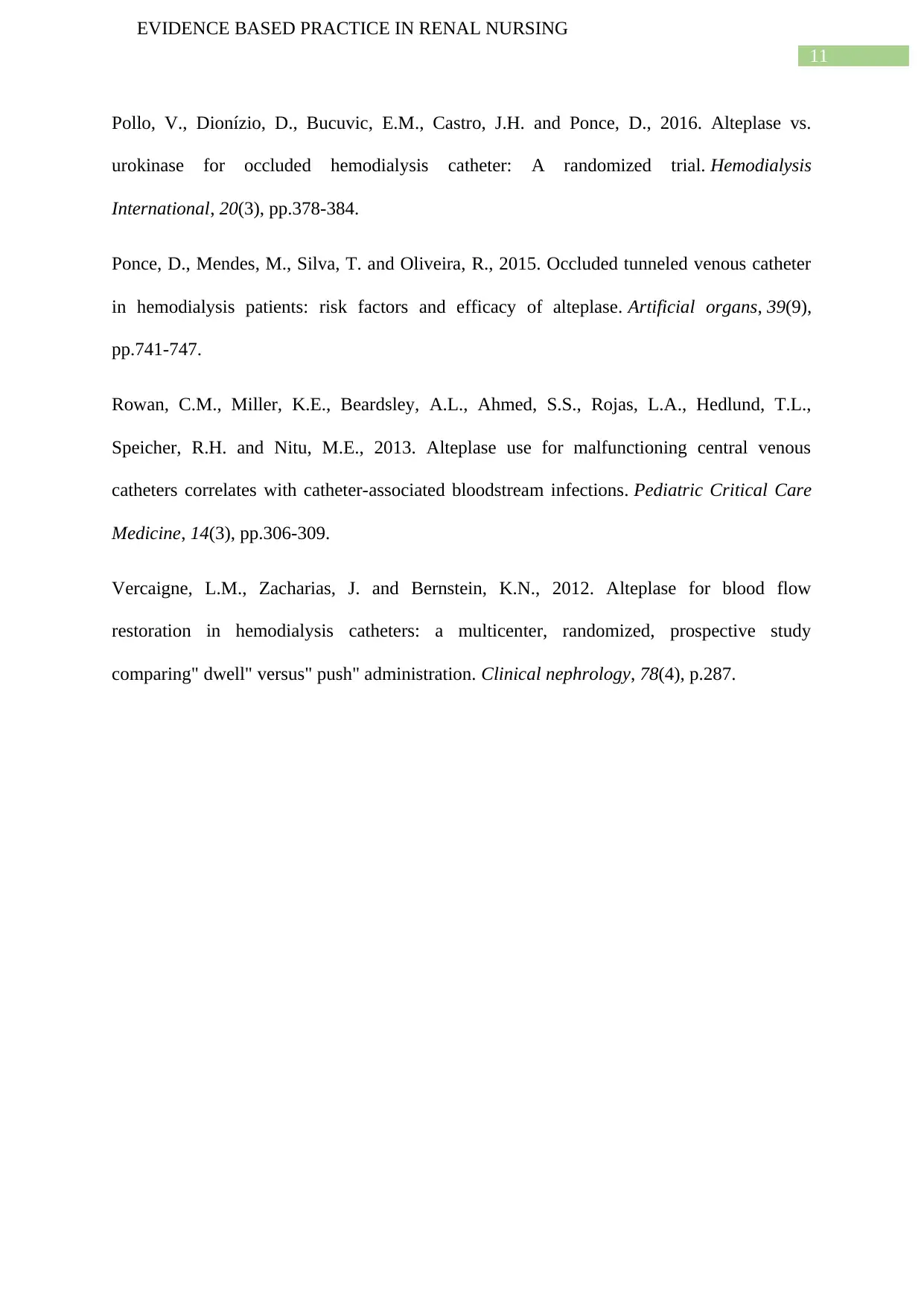
11
EVIDENCE BASED PRACTICE IN RENAL NURSING
Pollo, V., Dionízio, D., Bucuvic, E.M., Castro, J.H. and Ponce, D., 2016. Alteplase vs.
urokinase for occluded hemodialysis catheter: A randomized trial. Hemodialysis
International, 20(3), pp.378-384.
Ponce, D., Mendes, M., Silva, T. and Oliveira, R., 2015. Occluded tunneled venous catheter
in hemodialysis patients: risk factors and efficacy of alteplase. Artificial organs, 39(9),
pp.741-747.
Rowan, C.M., Miller, K.E., Beardsley, A.L., Ahmed, S.S., Rojas, L.A., Hedlund, T.L.,
Speicher, R.H. and Nitu, M.E., 2013. Alteplase use for malfunctioning central venous
catheters correlates with catheter-associated bloodstream infections. Pediatric Critical Care
Medicine, 14(3), pp.306-309.
Vercaigne, L.M., Zacharias, J. and Bernstein, K.N., 2012. Alteplase for blood flow
restoration in hemodialysis catheters: a multicenter, randomized, prospective study
comparing" dwell" versus" push" administration. Clinical nephrology, 78(4), p.287.
EVIDENCE BASED PRACTICE IN RENAL NURSING
Pollo, V., Dionízio, D., Bucuvic, E.M., Castro, J.H. and Ponce, D., 2016. Alteplase vs.
urokinase for occluded hemodialysis catheter: A randomized trial. Hemodialysis
International, 20(3), pp.378-384.
Ponce, D., Mendes, M., Silva, T. and Oliveira, R., 2015. Occluded tunneled venous catheter
in hemodialysis patients: risk factors and efficacy of alteplase. Artificial organs, 39(9),
pp.741-747.
Rowan, C.M., Miller, K.E., Beardsley, A.L., Ahmed, S.S., Rojas, L.A., Hedlund, T.L.,
Speicher, R.H. and Nitu, M.E., 2013. Alteplase use for malfunctioning central venous
catheters correlates with catheter-associated bloodstream infections. Pediatric Critical Care
Medicine, 14(3), pp.306-309.
Vercaigne, L.M., Zacharias, J. and Bernstein, K.N., 2012. Alteplase for blood flow
restoration in hemodialysis catheters: a multicenter, randomized, prospective study
comparing" dwell" versus" push" administration. Clinical nephrology, 78(4), p.287.
1 out of 11
Your All-in-One AI-Powered Toolkit for Academic Success.
+13062052269
info@desklib.com
Available 24*7 on WhatsApp / Email
![[object Object]](/_next/static/media/star-bottom.7253800d.svg)
Unlock your academic potential
Copyright © 2020–2025 A2Z Services. All Rights Reserved. Developed and managed by ZUCOL.


